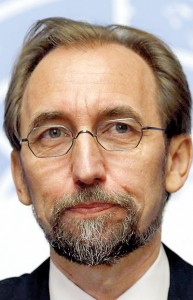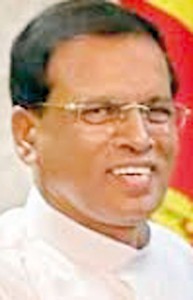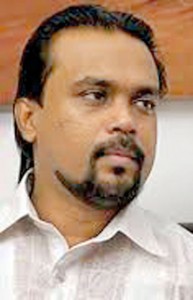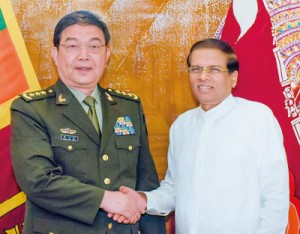Columns
Trump’s grace grants reprieve for Lanka
View(s):After Ban Ki-moon had met the then President Rajapaksa, a joint statement by the Lankan Government and the United Nations was issued which stated, amongst others, that “The Secretary-General underlined the importance of an accountability process for addressing violations of international humanitarian and human rights law. The Government will take measures to address those grievances.”
 A year later, the UN Chief announced the appointment of a Panel of Experts to advise him on the implementation of the joint commitment included in the statement issued by the President of Sri Lanka and the Secretary-General at the conclusion of the Secretary-General’s visit to Sri Lanka on March 23, 2009. The Lankan government reacted against it saying, it was ‘an unwarranted and unnecessary interference with a sovereign nation’
A year later, the UN Chief announced the appointment of a Panel of Experts to advise him on the implementation of the joint commitment included in the statement issued by the President of Sri Lanka and the Secretary-General at the conclusion of the Secretary-General’s visit to Sri Lanka on March 23, 2009. The Lankan government reacted against it saying, it was ‘an unwarranted and unnecessary interference with a sovereign nation’
The UN panel’s Darusman Report which ensued was highly critical of Lanka’s armed forces and held that they had found ‘credible allegations’ which, if proven, indicated that war crimes and crimes against humanity were committed by the Sri Lankan military and the LTTE. The conclusion of the panel was ‘the conduct of the war represented a grave assault on the entire regime of international law designed to prevent individual dignity during both peace and war’. The panel also held that they had found that as many as 40,000 civilians may have been killed in the last months of the war.

ZEID: UNHRC gives Lanka two year suspended sentence
Thus began the conflict between Lanka and the international community. The failure of Rajapaksa to keep his promise to implement the 13th Amendment fully and his growing intransigence stiffened world resolve against him and moved the American Government to publicly declare it wanted a regime change in Lanka.
The resolutions passed by the UN’s Human Right Council’s threatening sanctions were on course to reach its climax in 2015. It may have been one of the reasons which prompted Rajapaksa to call for elections in January of that year, two years before his term expired, in the belief that fortified with a fresh mandate from the people he would be better armed to face the UN’s challenge. It is of course highly unlikely that such a gambit would have worked at the UN body.
Thankfully for Lanka and her people, Rajapaksa was booted out of office and the red carpet was rolled for Sirisena to walk to power as the nation’s new president. And what a welcome breeze attended his advent in Lanka and found its way to Alpine peaks to peep into the UN’s Human Rights Commissioner’s office in Geneva; and to blow away the long settled dust on Lanka’s tarnished image and present her scented with lavender to the world in a fresh new redeeming light.
In March that year, not only did the UN body grant more time for the new government to keep the previous government’s international pledges, but in October, America made Lanka a co sponsor of the resolution on Lanka. In that resolution, among others, the Government undertook to appoint a war tribunal comprising foreign and local judges to mete out punishment to those who had committed war excesses. But the rainbow faded and the world’s face darkened when President Sirisena began to shake a leg to a new beat that the reality band of local politics began to play.
At a Panadura meeting held in July last year, he declared: “As long as I am the President of this country, I will not allow for any international courts, international judges and international organisations to interfere with the internal affairs of Sri Lanka and the judiciary.”
His statement came in the wake of UNHRC Chief Zeid’s report presented at the 32nd session of the Human Rights Council held on June 28 which stated: “The High Commissioner remains convinced that international participation in the accountability mechanisms would be a necessary guarantee for the independence and impartiality of the process in the eyes of victims, as Sri Lanka’s judicial institutions currently lack the credibility needed to gain their trust.”

SIRISENA: Stroke of luck courtesy Trump’s Israel policy
Sirisena’s bold reaction to Zeid’s demand seemed he was reneging on the promises made in the October resolution which the country had co-sponsored together with the United States and Lanka was in danger of slipping back into the bad books of the UN again, even as it had done when the former President had reneged on his.
Shortly after 10pm, Lankan time this Wednesday, the debate on Sri Lanka began at the 34th session of the United Nations Human Rights Council in Geneva. Earlier in the day, UN High Commissioner for Human Rights, Zeid al-Hussein, had told the 34th regular session of the Human Rights Council that they continue to underscore the concept of hybrid court to Sri Lanka to utilise an accountability mechanism. In that theatre of human rights, the scene was set for battle between the Lankan President’s adamant refusal to entertain any foreign judges and UN Zeid’s insistence upon their presence on the bench of a hybrid court. And since then, for the last six months and more, the vexed issue has been a bone of contention.
The British Government had also issued a statement and had praised the Lankan Government, “for taking the necessary steps to improve the human rights situation in Sri Lanka, in particular the restoration of important democratic checks and balances, improvements in respect for freedoms of expression and movement, the return of some military-held land, the passing of legislation to establish an Office for Missing Persons, the ratification of the Convention on Enforced Disappearances and the initiation of a process of constitutional reform. We commend these measures.”
But the British statement, after the bonhomie pat on the back, also warned the Lankan Government that much remained to be done and had urged the Government of Sri Lanka to provide the determined leadership required to deliver fully on the commitments it made when co-sponsoring resolution 30/01 and to develop a comprehensive and time bound implementation strategy. The statement also referred to the need to “establish credible transitional justice mechanisms.” The key word was ‘credible’. The issue of foreign judges was set to become a stumbling block.
But miracles happen overnight and America moves in mysterious ways at the United Nations. After Trump’s triumph in January, the US Government had served notice on the UN that if the UNHRC is not restructured in Trump’s image within six months, the US Government will withdraw its financial support to the Human Rights body.
With such a threat from the Almighty nation looming over the UNHRC’s head, its chief Zeid who the day before had underscored his demand for a hybrid court comprising foreign judges as well to hear war crimes allegation in Lanka, sought a compromise. Instead of the lion that roared the previous day, he became the pussycat that purred the following day.
The UN Human Rights Council adopted on Thursday a resolution, without a vote, granting two years to fulfil the resolution which Lanka had co-sponsored in Oct 2015. Lanka had been granted a two-year reprieve thanks to Trump’s saving grace. What it means is that the Sirisena Government can conduct its normal course of business without having to dread the coming of March or the onset of Autumn when the Geneva sessions take place annually for the next two years. Maithripala has been blessed with a Geneva miracle and has been gifted with a two-year summer to sort things out on the ethnic issue, including the controversial foreign judges matter.
But let no one think that it’s the government’s diplomacy that had earned Lanka a stay of execution. Nor think that Trump’s proclamation, before he became President that he was not concerned about human rights violations anywhere in the world, has blessed the Lankan Government and acquitted it of its responsibilities to meet its international obligations. The answer may well lie in the new American Government’s fixation of granting supremacy to Israel’s concerns and granting them a free hand to do as they wished on Palestinian territory.
Trump’s move to abandon the two-state concept in solving the long drawn Israel-Palestine conflict which had been for long the cornerstone of US policy; his suggestion to move the US Embassy from Tel Aviv to Jerusalem, a very sensitive issue, the blind eye cast towards Israel building houses on Palestinian territory and settling Jews upon its soil have great human rights ramifications which the US government will find hard and embarrassing to defend as a high profile member of the UN’s Human Rights Council. And while the great land of liberty is busy promoting Israel as the dominant power in that godforsaken region of conflict, the US government may well have thought it prudent to soft pedal on human rights issues committed elsewhere in the world by small nations of no great significance in its blinkered eyes.
The fallout from that policy is the windfall the Lankan Government reaped this Thursday. It has nothing to do with the government’s shabby performance in granting justice to all who were denied it during the war years. The Lankan government was only the beneficiary of the world’s sole superpower’s new policy and received its reprieve in the manner hundreds of criminals serving time in the country’s prisons receive presidential amnesty and are freed on Vesak day. Not because they are deemed innocent and deserve to be freed on account of good behavior but because a higher noble Buddhist motive to show compassion on that thrice blessed day, moves the President to show clemency.
Much remains to be done to build a lasting peace. The Government should utilise the time granted to make a genuine attempt to revive the reconciliation process even if it means having to dump the chauvinistic stance, political pressure from nationalistic bigoted joint opposition forces have forced it to adopt. It cannot wait for another Vesak.
| Wimal’s hunger show within remand wallsSunday Punch 2 Four walls do not a prison make for a drama queen to flaunt showman skills. Or to attempt a Houdini act to break free from remand bondage.  WIMAL: Fast one within remand walls Soon the Prison Warden’s worst fears were confirmed. |
| The flag follows trade on China’s Silk Route Sunday Punch 3 For the first time in the recent history of Sino-Lanka relations, the Chinese Defence Minister arrived on Monday in Lanka to shake hands with President Sirisena and to give him the assurance that China will support Lanka every step of the way to the ends of the world. During the last few years, there have been many trade delegations, trade and investment officials from China visiting Lanka, even a state visit by the Chinese President Xi to commission the Chinese built Norocholai coal plant in 2014. But no sudden drop in for a cup of green tea and a chat whatsoever from the defence establishment, especially not from one as high ranking as the Defense Minister.  INVESTMENT SAFEGUARDS: President meets China’s Defence Minister Thus the arrival of China’s Defence Minister General Chang Wanquan on Monday was indeed significant. But his declaration of unconditional support to Sri Lanka was no surprise and his pledges to provide military hardware, training and technical knowledge to the Sri Lankan armed forces and to further strengthen it were only to be expected. After all the Chinese Government has a lot to protect in Lanka, notably its port city in Colombo which it owns for the next 99 years on lease, not to forget, of course, the Hambantota Port, it will soon come to own and control. China has billions of dollars strategically invested in Lanka to safeguard, even by her military might should it come to that, so much so that the Lankan government is looking more and more a caretaker of Chinese property in this 25,000 square miles of land rather than the landlord of all he surveys. In the early 17th century the British East India Company, a joint stock company owned by wealthy merchants and members from Britain’s aristocracy began trading with the Indian subcontinent and the Orient. After years of doing business, trade wars with other foreign powers in the region compelled the British Government to send its naval fleet to protect its countrymen’s investments and pecuniary power. It ultimately led to the creation of the British Empire which held India as the Kohinoor diamond in its Empire’s crown. It’s the classic example where the flag soon followed trade. And this week, with the arrival of China’s Defence Minister to the island, wonder whether it’s another classic case of history repeating itself? That the Chinese flag is following Chinese trade on the silk route to regional domination? And whether the once proud pearl of the Indian Ocean, is now just another captive bead, dangling helpless in the wily Chinaman’s necklace? |


Leave a Reply
Post Comment